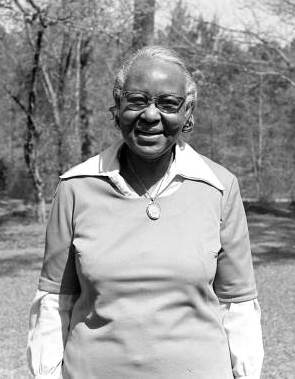Flora Mae Hunter facts for kids
Quick facts for kids
Flora Mae Hunter
|
|
|---|---|

Flora Mae Hunter photographed in 1988 for the Florida Folk Heritage Awards
|
|
| Born |
Flora Mae Ross
November 29, 1910 or 1911 |
| Died | December 8, 2003 |
| Occupation | Cook, cookbook author |
| Years active | c. 1926–1968 |
|
Notable work
|
Born in the Kitchen: Plain and Fancy Plantation Fixin's |
| Spouse(s) | Peter Hunter |
| Awards | Florida Folk Heritage Award |
Flora Mae Hunter (born Ross, November 29, 1910 or 1911 – December 8, 2003) was a famous American cook and author. She spent many years cooking on large farms called plantations in northern Florida. She worked for 36 years at Horseshoe Plantation near Tallahassee, Florida.
In 1979, she wrote a cookbook. It was called Born in the Kitchen: Plain and Fancy Plantation Fixin's. The book shared recipes she used for both the plantation owners and their workers. In 1988, Flora Mae Hunter received a special award. It was the Florida Folk Heritage Award for her important cultural contributions.
Contents
Early Life and Family Roots
Flora Mae Ross was born in 1910 or 1911. Her birthplace was Springhill Plantation in Thomas County, Georgia. This area is very close to the Florida border.
Her father, Eddie, worked as a handyman on the plantation. Her mother, Lessie (who lived from about 1886 to 1971), was a cook. Flora Mae had one sister and one brother. In 1914, her family moved to Tallahassee, Florida.
A Career in Cooking
Flora Mae left school when she was 15 years old. She joined her mother working in the kitchen. This was at Sunnyhill Plantation in Leon County, Florida. Sunnyhill was owned by Lewis Thompson. His father was a leader at Standard Oil.
During this time, many rich people from the north bought plantations in the southern states. They used these large farms for hunting. Many African-Americans who had been enslaved before the Civil War still lived in these areas. They often continued to work in similar jobs.
Learning and Traveling for Cooking
Flora Mae spent four years working with her mother. She learned many recipes, some passed down from her grandmother. Later, she worked at other plantations nearby, like Foshalee. These jobs allowed her to travel. She visited places like Morrisburg, Ontario, Canada, and Cleveland, Ohio.
After a year, she missed home. She returned to Tallahassee. She chose to stay in her community. This was different from many African-Americans who moved north during the Great Migration.
Cooking at Horseshoe Plantation
On March 9, 1933, Flora Mae, then 21, married Peter Hunter. Peter had worked at Horseshoe Plantation since about 1917. He stayed there for 57 years. Flora Mae's parents had started working there in 1916. The plantation was 13,000-acre (5,300 ha) and owned by Edith and George F. Baker. George Baker was the president of City Bank of New York. He used the plantation as a winter home for quail hunting.
Baker hired Flora Mae Hunter in 1933. He loved her cooking when she helped in the Horseshoe kitchen. He said her food was the best he had tasted in the South. He no longer needed a chef to travel with him from New York.
Flora Mae Hunter cooked at Horseshoe Plantation for 36 years. She retired in 1968. Her husband became the butler, overseeing the kitchen and choosing menus. She cooked for 30 staff members. She also cooked for the Bakers and their many guests.
Her cooking became famous around the world. Important people like the Duke and Duchess of Windsor (the former King Edward VIII and Wallis Simpson) visited often. The Duchess even joked that she gained three pounds (1.4 kg) every time she visited because the food was so good!
Two Styles of Cooking
Hunter cooked in two different styles. She made meals for the staff and for the owners and guests. For the workers, she might make "pigtail pilau with a side of fried okra and peach cobbler." For the Bakers, she prepared "turtle soup, pan-broiled venison, and tapioca pudding."
The Bakers and their guests only ate the best parts of the ducks. Hunter would give the rest of the birds to the plantation workers. This was similar to how food scraps were used in the past.
Later Life and Cookbook Success
By 1978, Flora Mae Hunter and her husband lived in a brick home. It was on four acres (1.6 ha) of land next to Horseshoe Plantation. Hunter was an important person in her community. She was vice-president of the Leon County Extension Homemakers' Council. She also led the Horseshoe Club, a group for sewing and crafts.
Writing Her Cookbook
In 1979, Hunter published her cookbook. It was called Born in the Kitchen: Plain and Fancy Plantation Fixin's. The book showed the two cooking styles she used. She also updated some recipes. For example, she used convenience foods in some recipes. She also changed her recipes to work in a gas oven. She had cooked on wood-burning stoves for most of her career.
Her recipes included "Horseshoe Eggs." This was a spicy egg casserole she created. She made it when Edith Baker wanted deviled eggs but there weren't enough. She also included rice cakes. These were like pancakes, good for breakfast or dessert. Other recipes were "Smothered quail" and "Southern syrup corn meal sweet bread."
Hunter started her own company, Pine Cone Press. She wanted to publish Born in the Kitchen herself. She turned down offers from big publishers. She wanted to control her book's content. She worked with Florida A&M University professor Thelma Gorman as her editor. Hunter planned for the book's profits to help fund education.
Awards and Recognition
In 1988, Flora Mae Hunter received the Florida Folk Heritage Award. This award honors artists who have greatly contributed to the state's culture. She received it at the annual Florida Folk Festival. About 20,000 people attended the festival.

